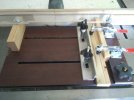I need to come to terms with my router table as I have many more picture frames and small projects on the waiting list. Honestly, the router table scares the heck out of me.
Anyway, looking at the various coping sleds. Most ride against the fence. They look very similar, either DIY or machined. Of course Woodpeckers makes theirs complicated for double what everyone else wants. Not sure I see more utility in it though.
$70 to $90 Fulton, MLCS, PowerTec, Rockler, Infinity, WoodRiver, and others, with DIY like the Stumpy. All similar in concept. Small details different. Any wisdom in this? All cheap enough to taunt me rather than DIY. I gather like a lot of jigs, the heavier the better until it is unwieldy.
Is there an advantage of being against the fence vs in the T-Slot?
None of the above seem to be set up to do cuts on mitered stock. Something I think would be most useful in my frame work.
I have the Kreg plate, Triton router, Rockler fence, in a SawStop iron table.
Also looking for options maybe more advanced for running small thin moldings. So far, I have run them on bigger stock then ripped it off on the TS.
Anyway, looking at the various coping sleds. Most ride against the fence. They look very similar, either DIY or machined. Of course Woodpeckers makes theirs complicated for double what everyone else wants. Not sure I see more utility in it though.
$70 to $90 Fulton, MLCS, PowerTec, Rockler, Infinity, WoodRiver, and others, with DIY like the Stumpy. All similar in concept. Small details different. Any wisdom in this? All cheap enough to taunt me rather than DIY. I gather like a lot of jigs, the heavier the better until it is unwieldy.
Is there an advantage of being against the fence vs in the T-Slot?
None of the above seem to be set up to do cuts on mitered stock. Something I think would be most useful in my frame work.
I have the Kreg plate, Triton router, Rockler fence, in a SawStop iron table.
Also looking for options maybe more advanced for running small thin moldings. So far, I have run them on bigger stock then ripped it off on the TS.

